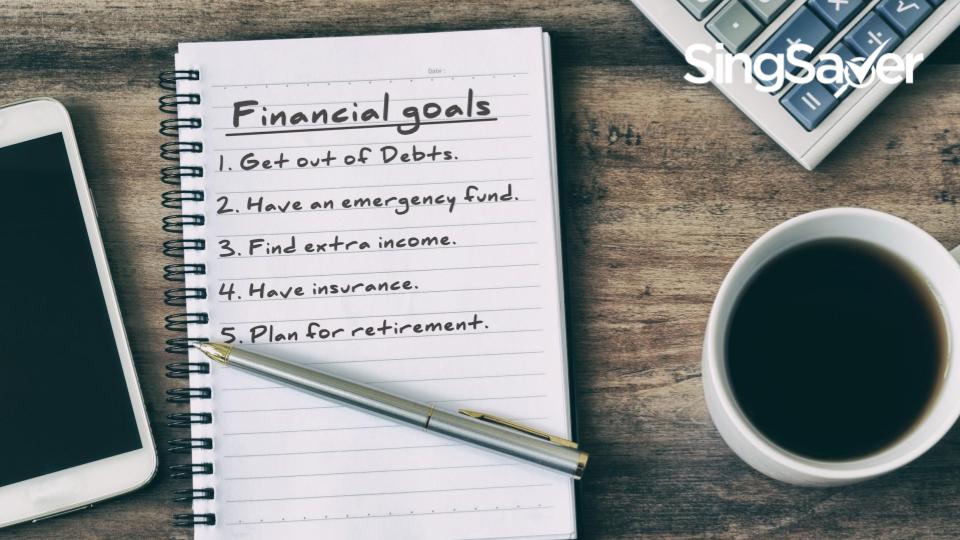
Wondering what adulting looks like? These 5 financial goals will guide you nicely towards being a respectable, fully-formed adult.
There’s a sort of magic associated with the age of 35.
At this age, you’re typically considered to be at your peak, mature enough to know what exactly you want out of life. You possess the vim and vigour to go after your goals and dreams, yet still idealistic and hopeful because life hasn’t made you jaded.
Even the government thinks you’re finally ready to buy an HDB flat by yourself.
The best way to celebrate your entry into #adulting is by achieving these 5 financial goals. Warning: these are not just goals, they are major milestones. So put on your adult pants and get cracking.
Aim for these 5 financial goals before your 35th birthday
| Goal 1: Get out of debt Step 1: Total up your entire debt Step 2: Work out how much you can pay towards debt each month Step 3: Construct a simple debt payment worksheet Step 4: Celebrate small victories/milestones Step 5: Keep it up until you’re done |
| Goal 2: Be properly insured Step 1: List out your financial obligations Step 2: Calculate your assets Step 3: Work out the difference between the two Step 4: Purchase sufficient insurance to bridge the gap |
| Goal 3: Have an emergency fund Step 1: Calculate your barebones monthly budget (daily expenses and essential bills only) Step 2: Plan how to save up this amount (reduce expenses, get a side gig, year-end bonuses etc) Step 3: Build up your emergency savings to 6 - 12 months worth of your barebones budget |
| Goal 4: Save for a wedding or a flat Step 1: Work out the cost of your wedding banquet, honeymoon or the downpayment for your HDB flat/condo Step 2: Divide by the remaining number of months till age 35 Step 3: Set up an automatic funds transfer to save that amount every month |
| Goal 5: Start investing for your retirement Step 1: Construct an investment portfolio with a 55 year timeline (30 years growth, 25 years sustain)Step 2: Aim to invest 20% of your monthly income Step 3: Decide how to handle dividends and bonuses |
- Get out of debt
- Be properly insured
- Build emergency fund
- Save for a wedding or flat
- Invest for retirement
- Tips & tricks to score these 5 life goals
Goal 1: Get out of debt
One of the most important things you can do for your financial health is to become (and stay) debt free. This will ensure that you can fulfil your other financial goals without any further hindrance.
Maybe you’re servicing a student loan. Or maybe you have a pesky balance that you’ve been juggling between credit cards. Whatever your debts are, make a plan to pay them off by age 35 (or sooner, if possible).
Follow these steps to help you along:
- Total up your entire debt. When you know for sure how much debt you actually carry, you’ll be that much more motivated to do something about it.
- Work out how much you can pay off each month. To do so accurately, take your income, then deduct daily expenses and essentials. Then commit the remaining to paying off your debt. It may be worthwhile to temporarily pause your savings until you’re debt free.
- Construct a simple debt payment worksheet to help you keep track, especially if you owe balances between multiple credit cards. Also, consider consolidating your credit card debts into one using a Balance Transferr or Personal Loan (more on that below).
- Start paying down your debt. When you hit a milestone (such as 25% done, one credit card cleared, etc), remember to celebrate. Acknowledging your efforts will help you keep going.
- Keep going until you’re free of debt.
Goal 2: Be properly insured
By the time you hit 35, you’ll be at a certain station in life, and probably have a concrete idea of the kind of life you want.
You need to ensure that should something untoward happen to you, your loved ones or dependents can continue to maintain a similar standard of living. This is where insurance comes in.
But what kind of insurance, and how much? Simply put, there are two main areas to consider.
The first is healthcare and hospitalisation, which, as a Singaporean, you are already (at least partially) covered for. It is worth considering extending your cover and benefits with an Integrated Plan (IP). This gives you higher claims limits, higher-class hospital wards and alternative treatments.
The limits, however, still depends on the exact IP you choose, which comes in different premium tiers. Do note that you’ll need to pay the IP premiums in cash, while your basic MediShield still remains payable via your MediSave.
The second area to consider is life insurance, which you will use to cover the gap between your financial obligations and your current assets. Follow these steps:
- List out your financial obligations, and extrapolate into the future. For example, if your current household expenses (essentials only) with two young children is $4,000 per month, and you want to protect them for 20 years (until they reach adulthood), your family expenses would total $4,000 x 12 months x 20 years = $960,000. Next add any other obligations, such as debt, mortgages, car loans, etc.
- Then, calculate your current assets, including savings and valuable items.
- Find the difference between (1) and (2). That’s the gap you need to cover.
- Talk to a professional financial adviser to work out a comprehensive insurance portfolio to cover that gap.
Goal 3: Have an emergency fund equal to 12X monthly expenses
An emergency fund is like an umbrella: ignored when you don’t need it, and suddenly very precious when you do. Hopefully, you are familiar with the idea of an emergency fund. Perhaps you may already be working on one yourself.
When you reach 35, it is a good idea to have a pool of money you can tap on during emergencies, and it should be big enough to cover 12 months of your expenses.
This will become an important support pillar in case you want to make a career change, suffer an upheaval due to uncontrollable events (like COVID-19, but hopefully never again), or if you decide to strike out on your own.
Before you panic, we’re talking about 12 months of expenses, which, when pared down to the essentials, should be markedly lower than your income. Still, it is a fairly large sum to achieve, so treat your emergency fund as an ongoing work-in-progress.
Here are the steps to follow when establishing an emergency fund.
- Calculate your barebones monthly expenses, which should comprise daily expenses and essential bills only. Cut everything else out.
- Decide how to fund your emergency fund. Maybe you can carve out a portion of your monthly budget. Or take up some extra work on the weekends.
- Aim to accumulate 12X of your barebones monthly expenses by your 35th birthday.
- Most importantly, get started!
Goal 4: Save for a wedding or a flat
Getting married and/or getting your own flat is among one of the biggest milestones in your life. It can also be quite costly, so it certainly pays to get ready for it.
This one is really quite simple. You’re aiming to have enough funds to pay for a wedding banquet and/or honeymoon which can easily cost tens of thousands.
Similarly, the downpayment of your own flat (to be paid in cash) can be anywhere from 5% to 20% of the transaction price, depending on your property type, mortgage scheme, and the balance in your CPF Ordinary Account.
Here’s how you can go about saving for a wedding or a flat:
- Decide on the type of wedding banquet you want to have, your honeymoon destination, and the dream home you want.
- Based on the above, work out a likely budget for the wedding or home down payment.
- Count how many months you have from now till you turn 35, and divide your budget up accordingly.
- And because you want this to be a non-negotiable goal, set up an automatic fund transfer to deduct this amount from your paycheck every month.
Goal 5: Start investing for your retirement
By the time you hit 35, you’re in the prime of your life. So it may be a little jarring to consider that retirement is only another 30 or so years away.
Because compounding interest needs time to work its magic, the sooner you begin investing for your retirement, the better off you’ll be.
Here’s how you can go about investing for your retirement:
- Work with a professional financial adviser to construct a personalised retirement portfolio. As a general rule, your portfolio should last till the end of your life. Hence, at 35, a 55 year plan will cover you till age 90.
- Your investment portfolio should consist of two phases: a growth phase, followed by a sustain phase. Your growth phase should last during your working years (so 30 years, at least), and should be tuned to grow and accumulate your wealth. When you retire at 65 (or whichever age), your portfolio should shift into a sustain phase, with the goal of keeping pace with inflation while maintaining stability and liquidity.
- As a general rule, aim to invest 20% of your monthly income each month to ensure sufficient retirement funds.
- Decide how you will handle dividends and bonuses, so you don’t get sidetracked when your investments start bearing fruit. When in doubt, re-invest.
Yes, this goal ignores your CPF Life annuity payouts and the potential monetisation from your property.
Our reasoning is this: by ensuring self sufficiency with a simple and disciplined investing schedule, you can stop worrying about whether your CPF LIfe payouts will be sufficient in your golden years. Instead, you’ll get to enjoy your property and CPF LIfe payouts as nice bonuses.
Tips and advice to help you achieve your financial goals
Achieving these goals can seem daunting. Here are some tips, tools and advice to help you along.
Endowment plans can help you save and insure
Endowment plans are a type of regular savings plan with insurance benefits.
The most common or basic insurance benefit is a death benefit, which pays out in case of death or total disability – just like a life insurance plan.
You may also choose to add riders for additional benefits, such as personal accident or critical illness cover. In this way, an endowment plan can help to fulfil some of your insurance requirements.
On the savings end, some endowments offer a cashback option, allowing you to withdraw a portion of your accumulated cash value every year. With some careful planning, you can subscribe to an endowment and accumulate enough cashback to fund your wedding banquet, honeymoon or other big-ticket items.
Do be aware that endowments require a long-term commitment and must be held to maturity, or severe penalties will apply. Always speak with a qualified professional for a complete understanding before signing up.
Balance Transfers and Personal Loans can help you manage debt
The first phase of getting out of debt is to get a handle on it, and there are financial tools that can help.
Take for example Balance Transfers, which is a lump-sum loan with an interest-free period period that slashes your interest payments to zero.
So if you have, say multiple credit card balances totalling $8,000, you can use a balance transfer to borrow $8,000 to pay off all your cards. Then, make use of the interest-free period (typically 6 to 12 months) to pay back the $8,000 owed on the Balance Transfer.
This way, instead of juggling multiple card payments, you only have to focus on the balance transfer. More importantly, you’ll save a chunk on interest charges.
If you need a longer repayment period that you can get from a balance transfer, consider a personal loan, which comes available with loan tenures from one to five years (and in some cases, up to seven years). The longer the loan tenure, the lower your monthly payments will be. However, a longer long tenure also means you are paying more in the long run due to the interest rate, so be sure to choose a tenure that suits your budget.
The idea is similar; use the personal loan to clear off your credit card balances, then focus on making each monthly instalment until the Personal Loan is paid off.
Another advantage is personal loans have lower interest charges than credit cards (but not as low as a Balance Transfer), which reduces the amount of interest you have to pay.
Read these next:
DBS Multiplier Is The Most Pandemic-proof Savings Account Yet. Here’s Why.
Should You Always Pay Your HDB Downpayment With Cash Or CPF?
Personal Loan Promotions In Singapore 2021
Best Mortgage Insurance In Singapore (2021)
3 New Pay-As-You-Go Insurance Plans To Consider In 2021
Similar articles
Financial Health Check: Do You Know Your Debt Asset Ratio?
Your Attitude Towards Money Needs to Change When You’re 35 Years Old
Financial Goals For 2020 By Your Age: 20s, 30s, 40s, 50s
5 Steps to Reaching Your Financial Goals
Q2 Financial Check-In: Am I On Track For My Financial Goals?
6 Signs of Financial Stability in Singapore
5 Tips For Millennials To Start Adulting Financially
Financial Planning for Women: 4 Things to Do Right Now for Better Financial Health










